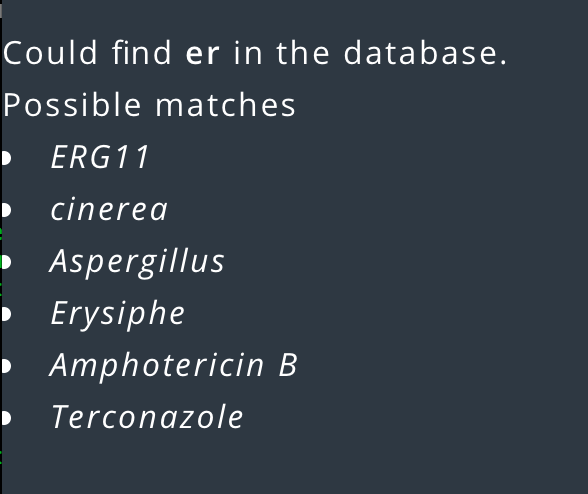FAQ
Search Instructions and Troubleshooting
Who can use MARDy?
MARDy is available for non-commericial use. All information is freely available, however, please cite our work!
Something went wrong!
We try our utmost to ensure that MARDy remains bug-free. However, it is inevitable that one or two bugs may creep in during the initial release phase. If you encounter a problem that is not addressed in the comments below, please contact a member of the team by the email link found at the bottom of each page.
How to cite MARDy?
Until MARDy is published in an international journal please cite our website directly.
Does that mutation really confer resistance?
The short answer: it probably has something to do with resistance. The long answer: MARDy holds references to amino acid substitutions and ploidy variation that are present in isolates demonstrating the corresponding MIC breakpoint for a particular drug (according to the CLSI Subcommittee for Antifungal Testing). Some of the literature reports the precise amino acid substitution combinations, whilst others only list identified changes against a reference genome. We have supplied both, along with the corresponding reference.
How do I search the MARDy database?
MARDy will perform a database search over single search queries of either a drug name, gene name or an organism name. An organism name can be split into a genus, a species or a genus species. Whilst inputting a search term a selectable list will appear of all matching database terms to aid your query.

If any of the selectable entries fail to match your query, then your query does not exist in the database and pursuit of that query will result in no matches.

If you perform a search on a query that does not exist, the results page will inform you of any nearest matches.
Tabulated results are written out to a comma separated variable (CSV) file, which is made available following the link at the bottom of the result page.

What is the Gene Locus?
The gene locus is the position of that gene against the reference genome. In organisms where the genome has not been sequences, this field will appear empty and there will be no corresponding gene sequence in the local BLASTn database.
I can see a database entry but a search does not return any results.
There are two likely reasons why an entry visible in the selection list fails to display tabulated resistance data in the results page; 1) the team is busy entering the data, or 2) floating white space (spacebar characters at the end of a string) has not been trimmed from the search term. We are working on improving the search capability of MARDy, however, during its early please be succinct with your search term.
How can I BLAST a gene sequence?
A local distribution of BLASTn (version 2.6.0) can be called from the MARDy website. Every gene entry in MARDy will have a corresponding gene sequence in the local BLAST database; a unique FASTA name is compiled from a given gene name and locus on entry into the MARDy database. As either a FASTA format or just a gene sequence, your gene entry is compared to our local database of gene sequences. A successful match with any number of stored sequences is returned on a results page and as a downloadable file. Sites of potential single nucleotide polymorphisms are highlighted in red.

The FASTA header from successful hits can be used to query the MARDy database for fungal resistance information.
